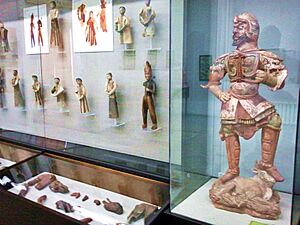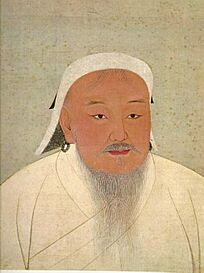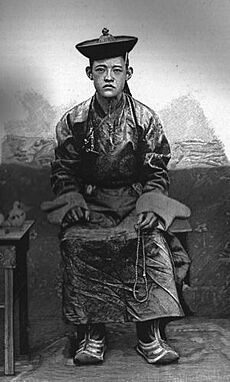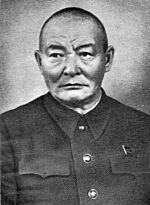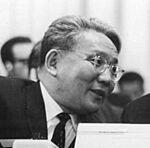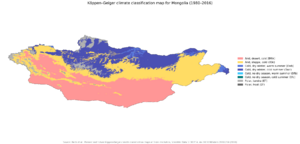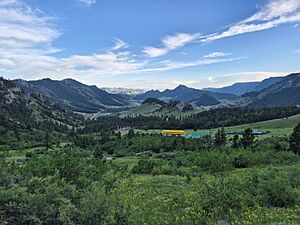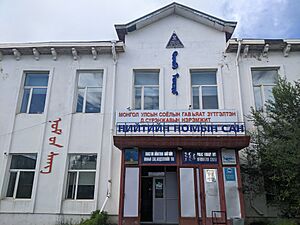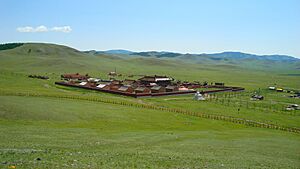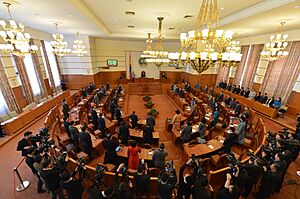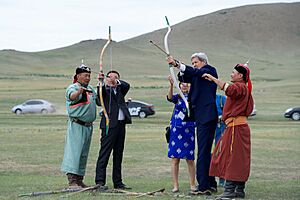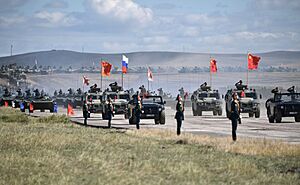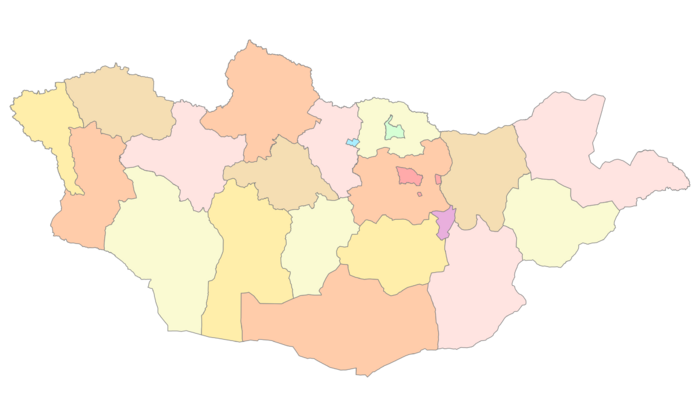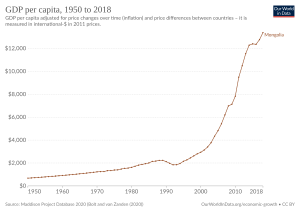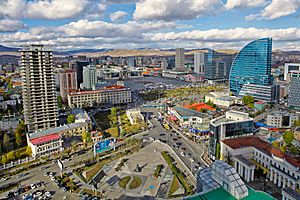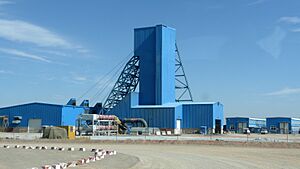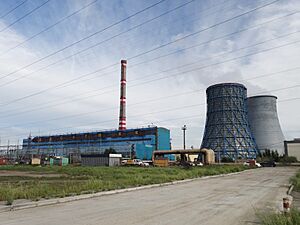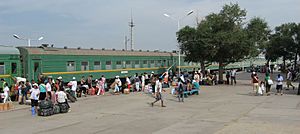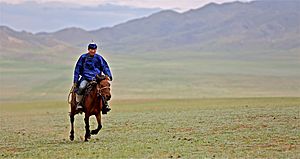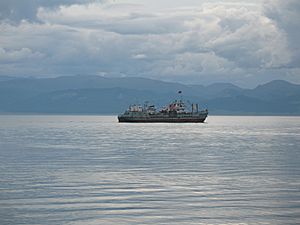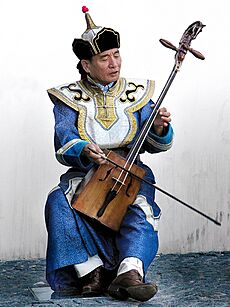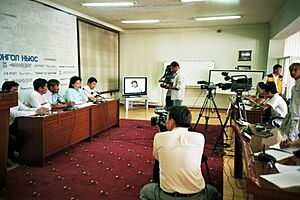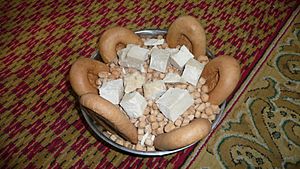Mongolia facts for kids
Quick facts for kids
Mongolia
|
|
|---|---|
|
|
|
|
Anthem: Монгол улсын төрийн дуулал
Mongol ulsyn töriin duulal "National Anthem of Mongolia" |
|
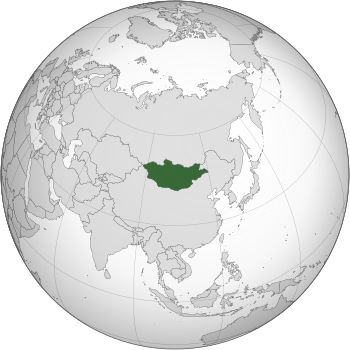 |
|
| Capital and largest city
|
Ulaanbaatar |
| Official languages | Mongolian |
| Official scripts |
|
| Ethnic groups
(2020)
|
|
| Religion
(2020)
|
|
| Demonym(s) | Mongolian, Mongol |
| Government | Unitary semi-presidential republic |
| Ukhnaagiin Khürelsükh | |
| Gombojavyn Zandanshatar | |
|
• Chairman of the State Great Khural
|
Dashzegviin Amarbayasgalan |
| Legislature | State Great Khural |
| Formation | |
|
• Xiongnu
|
3rd century BC |
|
• Xianbei
|
209 BC |
| 330 AD | |
|
• Khamag Mongol
|
1125 |
| 1206 | |
| 1368 | |
| 1634 | |
|
• Completion of Qing dynasty conquest
|
1691, 1758 |
|
• Bogd Khanate
|
29 December 1911 |
|
• Mongolian People's Republic established
|
26 November 1924 |
|
• Current constitution
|
12 February 1992 |
| Area | |
|
• Total
|
1,564,116 km2 (603,909 sq mi) (18th) |
|
• Water (%)
|
0.67 |
| Population | |
|
• 2023 estimate
|
3,504,741 (131th) |
|
• Density
|
2.24/km2 (5.8/sq mi) (238th) |
| GDP (PPP) | 2025 estimate |
|
• Total
|
|
|
• Per capita
|
|
| GDP (nominal) | 2025 estimate |
|
• Total
|
|
|
• Per capita
|
|
| Gini (2018) | 32.7 medium |
| HDI (2023) | high · 104th |
| Currency | Tögrög (MNT) |
| Time zone | UTC+7/+8 |
| Driving side | right |
| Calling code | +976 |
| ISO 3166 code | MN |
| Internet TLD | .mn, .мон |
Mongolia is a country in East Asia. It is a landlocked country, meaning it has no coastlines. Russia borders it to the north, and China to the south and southeast. Mongolia is huge, covering about 1.56 million square kilometers (603,909 square miles).
With only 3.5 million people, it is the world's most sparsely populated country. Much of Mongolia is covered by grassy steppe, with mountains in the north and west. The famous Gobi Desert is in the south. Ulaanbaatar, the capital and largest city, is home to about half of the country's population.
Mongolia's land has been home to many nomadic empires throughout history. These include the Xiongnu, Xianbei, and Rouran. In 1206, Genghis Khan created the Mongol Empire. This empire became the largest land empire in history. His grandson, Kublai Khan, later conquered China and started the Yuan dynasty. After the Yuan dynasty fell, the Mongols returned to their homeland.
In the 16th century, Tibetan Buddhism became popular in Mongolia. The Manchu-led Qing dynasty later took control of the country in the 17th century. By the early 1900s, many men in Mongolia were Buddhist monks. When the Qing dynasty collapsed in 1911, Mongolia declared its independence. It gained full independence from the Republic of China in 1921. Soon after, it became a close ally of the Soviet Union. In 1924, the Mongolian People's Republic was formed as a socialist state. After the revolutions of 1989 in other countries, Mongolia had its own peaceful democratic revolution in 1990. This led to a multi-party system, a new constitution in 1992, and a move towards a market economy.
About 30% of Mongolians are nomadic or semi-nomadic. Horses are still very important to their way of life. Buddhism is the main religion, followed by 51.7% of the people. About 40.6% of the population does not follow a religion. Islam is the third-largest religion, mainly among Kazakhs. Most citizens are ethnic Mongols. About 5% are Kazakhs, Tuvans, and other groups, mostly in western Mongolia. Mongolia is a member of the United Nations and the World Trade Organization.
Contents
The Name of Mongolia
| Mongolia | |||||
|---|---|---|---|---|---|
| Mongolian name | |||||
| Mongolian Cyrillic | Монгол Улс (Mongol Uls) |
||||
| Mongolian script | ᠮᠣᠩᠭᠣᠯ ᠤᠯᠤᠰ |
||||
|
|||||
The name "Mongolia" means "Land of the Mongols." The word "Mongol" (монгол) has an unclear origin. Some historians think it comes from "Mugulü," a leader from the 4th century.
After the Liao dynasty fell in 1125, the Khamag Mongols became a strong tribe on the Mongolian Plateau. They fought wars with the Jurchen-led Jin dynasty and the Tatar confederation. This weakened them. The last leader of the tribe was Yesugei. His son, Temüjin, later united all the tribes. He formed the Mongol Empire (Yekhe Monggol Ulus). In the 13th century, "Mongol" became a general term for many Mongolic-speaking tribes. These tribes were all united under Genghis Khan.
Since a new constitution was adopted on February 13, 1992, the country's official name is "Mongolia" (Mongol Uls).
History of Mongolia
Ancient Times
Evidence of early human life in Mongolia comes from the Khoit Tsenkher Cave. It has paintings from 20,000 years ago. These paintings show mammoths, lynx, and ostriches. The Venus figurines of Mal'ta (21,000 years ago) also show ancient art in northern Mongolia.
Early farming villages existed around 5500–3500 BC. Then, horse-riding nomadism became the main way of life. This was a very important change in Mongolia's history. Archeological finds show horse-riding nomads from the Copper and Bronze Ages. These include the Afanasevo culture (3500–2500 BC).
Monuments from the Bronze Age include deer stones and square slab tombs. Farming has continued since ancient times. However, it has always been smaller than nomadic herding.
Early Empires
Mongolia has always been home to nomads. From time to time, these nomads formed large groups that became powerful empires. These empires often had a Khan (leader) and a Kurultai (Supreme Council). They also used a decimal system for their armies.
The first of these empires was the Xiongnu. They formed a confederation in 209 BC. They were a big threat to the Qin dynasty in China. This led China to build the Great Wall of China for defense. The Xiongnu empire lasted until 93 AD.
After the Xiongnu came the Mongolic Xianbei empire (93–234 AD). Then, the Mongolic Rouran Khaganate (330–555) was the first to use "Khagan" as an imperial title. They were defeated by the Göktürks (555–745), who formed an even larger empire. The Uyghur Khaganate (745–840) followed them. Later, the Mongolic Khitans ruled Mongolia during the Liao dynasty (907–1125).
Mongol Empire and Later History
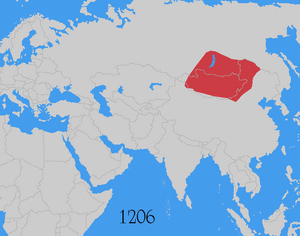
In the late 12th century, a leader named Temüjin united the Mongol tribes. In 1206, he became Genghis Khan. He led many military campaigns across Asia. This created the Mongol Empire, the largest land empire in history. It stretched from Poland to Korea and from Siberia to Vietnam. It covered about 33 million square kilometers (12.7 million square miles). This was 22% of Earth's land area.
After Genghis Khan died, the empire was divided into four kingdoms. One of these, the "Great Khaanate," included the Mongol homeland and most of China. This became the Yuan dynasty under Kublai Khan, Genghis Khan's grandson. He made his capital in what is now Beijing.
The Yuan dynasty was overthrown by the Ming dynasty in 1368. The Yuan court moved north, becoming the Northern Yuan dynasty. The Ming armies attacked the Mongols in their homeland. They destroyed the Mongol capital, Karakorum.
In the early 16th century, Dayan Khan and his wife Mandukhai reunited all Mongol groups. In the mid-16th century, Altan Khan became powerful. He founded Hohhot in 1557. He met with the Dalai Lama in 1578. After this meeting, Tibetan Buddhism was brought to Mongolia. Many Mongol leaders and people adopted Buddhism. Monasteries became very powerful.
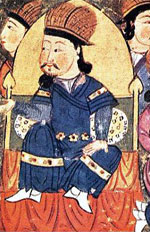
The last Mongol Khagan was Ligden Khan in the early 17th century. He had conflicts with the Manchus. He died in 1634. By 1636, most Inner Mongolian tribes had joined the Manchus. The Manchus founded the Qing dynasty. The Khalkha Mongols also joined Qing rule in 1691. This brought all of today's Mongolia under Manchu control. The Manchus did not allow many Chinese people to move into the area. This helped Mongols keep their culture.
By 1911, there were 700 monasteries in Outer Mongolia. About 115,000 monks lived there, making up 21% of the population.
Modern History
When the Qing dynasty fell in 1911, Mongolia, led by the Bogd Khaan, declared its independence. However, the new Republic of China claimed Mongolia as its territory. Bogd Khaan argued that both Mongolia and China were ruled by the Manchu. So, when the Qing dynasty fell, Mongolia's agreement to be under Manchu rule was no longer valid.
In 1919, Chinese troops occupied Mongolia. In 1921, White Russian Lieutenant General Baron Ungern defeated the Chinese forces in Niislel Khüree (now Ulaanbaatar). To remove Ungern's threat, Bolshevik Russia supported a communist Mongolian government. Mongolia declared independence again on July 11, 1921. For the next 70 years, Mongolia was closely linked to the Soviet Union.
Mongolian People's Republic
In 1924, after the Bogd Khaan passed away, Mongolia's government changed. The Mongolian People's Republic was formed. In 1928, Khorloogiin Choibalsan became a powerful leader. He started to collectivize livestock and destroy Buddhist monasteries. He also carried out purges, which led to the deaths of many monks and leaders.
In the 1920s, about one-third of Mongolian men were monks. By the late 1930s, almost all 750 monasteries were destroyed or looted. An estimated 17,000 monks were killed. Leaders who did not follow Stalin's orders were executed. The purges between 1937 and 1939 killed over 30,000 people.
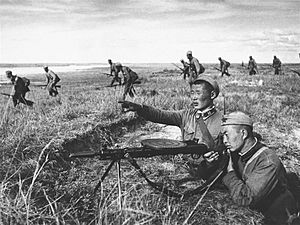
After Japan invaded Manchuria in 1931, Mongolia faced a threat. During the Soviet-Japanese Border War in 1939, the Soviet Union helped Mongolia defend against Japan. Mongolia also fought Japan in 1945 to free Inner Mongolia.
Cold War Era
In February 1945, the Yalta Conference decided that Outer Mongolia would remain independent after World War II. A referendum was held on October 20, 1945. Official numbers showed 100% of voters chose independence.
After the People's Republic of China was formed, both countries recognized each other in 1949. However, the Republic of China (Taiwan) blocked Mongolia's entry to the United Nations in 1955. They claimed all of Mongolia was part of China. Mongolia finally joined the UN in 1961. This happened after the Soviet Union agreed to allow Mauritania to join the UN.
On January 26, 1952, Yumjaagiin Tsedenbal became Mongolia's leader after Choibalsan died. Tsedenbal led Mongolia for over 30 years. In August 1984, he retired due to illness. Jambyn Batmönkh replaced him.
After the Cold War
The dissolution of the Soviet Union in 1991 greatly changed Mongolia. In January 1990, its people had a peaceful Democratic Revolution. This led to a multi-party system and a market economy. The former Marxist-Leninist Mongolian People's Revolutionary Party became the social democratic Mongolian People's Party. This changed the country's politics.
A new constitution was adopted in 1992. The term "People's Republic" was removed from the country's name. The move to a market economy was difficult at first. In the early 1990s, Mongolia faced high inflation and food shortages. Non-communist parties won elections in 1993 (presidential) and 1996 (parliamentary). China has supported Mongolia's efforts to join regional groups.
Geography and Climate
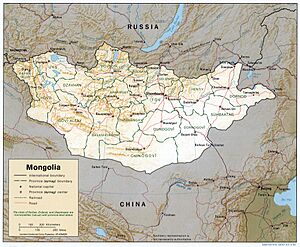
Mongolia is the world's 18th-largest country. It covers about 1.56 million square kilometers (603,909 square miles). It is much larger than Peru, the next largest country. Mongolia is mostly between 41° and 52°N latitude and 87° and 120°E longitude.
Mongolia's geography is diverse. The Gobi Desert is in the south. Cold, mountainous regions are in the north and west. Much of Mongolia is Mongolian-Manchurian grassland. Forests cover about 11.2% of the land. The highest point is Khüiten Peak, at 4,374 meters (14,350 feet) in the far west. The Uvs Lake basin, shared with Russia, is a World Heritage Site.
Mongolia's Climate
Mongolia is often called the "Land of the Eternal Blue Sky." This is because it has over 250 sunny days each year.
Most of the country has hot summers and very cold winters. January temperatures can drop to -30°C (-22°F). A large mass of cold air from Siberia causes these very cold temperatures in winter. River valleys and low areas get the coldest. Mountain slopes are often warmer due to a temperature inversion.
In winter, the Siberian Anticyclone affects all of Mongolia. The coldest areas are in Uvs province and parts of Khovsgol and Zavkhan. Ulaanbaatar is also cold but less extreme. The cold lessens as you go south, with the warmest January temperatures in Omnogovi Province.
Mongolia sometimes experiences harsh weather called zud. This causes many livestock to die from starvation or freezing. This leads to economic problems for the nomadic people. Ulaanbaatar is the world's coldest capital city, with an average annual temperature of -1.3°C (29.7°F).
Mongolia has an extreme continental climate. It has long, cold winters and short summers. Most of its yearly rain falls in summer. The country averages 257 cloudless days a year. Rainfall is highest in the north (200 to 350 mm per year). It is lowest in the south (100 to 200 mm annually).
Wildlife in Mongolia
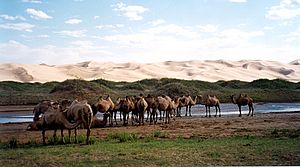
The word "Gobi" is a Mongol term for a desert steppe. This is a dry grassland with enough plants for camels, but not for small animals like marmots. Mongols tell the difference between Gobi and true desert. True deserts are stony and cannot support even camels.
Gobi grasslands are delicate. They can be easily damaged by too much grazing. This leads to the desert expanding. The dry conditions in the Gobi are caused by the rain shadow effect from the Himalayas. Before the Himalayas formed, Mongolia had more animals.
Fossils of sea turtles and mollusks have been found in the Gobi. Dinosaur fossils are also well-known there. Tadpole shrimps still live in the Gobi today. The eastern part of Mongolia, including the Onon and Kherlen rivers, is part of the Amur river basin. This area has unique species like the Eastern brook lamprey.
People of Mongolia
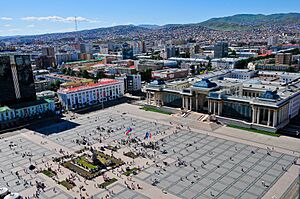
Mongolia's total population in 2024 was 3,544,835. This includes citizens living in Mongolia and abroad. About 51% of the population is female and 49% is male. Most people (71.2%) live in cities. Only 21.8% live in rural areas. Mongolia's population growth rate was about 1.2% in 2007.
In the 20th century, the first census in 1918 counted 647,500 people. After the end of socialism, Mongolia saw a big drop in its birth rate. However, it increased again to about 2.5-2.6 children per woman around 2020.
Mongols are quite similar to each other. Ethnic Mongols make up about 95% of the population. They include Khalkha and other groups, who speak different dialects of the Mongol language. The Khalkha make up 86% of ethnic Mongols. The other 14% include Oirats and Buryats. Turkic peoples, like Kazakhs and Tuvans, make up 4.5% of the population. The rest are Russian, Chinese, Korean, and American.
Languages Spoken
Mongolia's official language is Mongolian. It is part of the Mongolic language family. The standard dialect is Khalkha Mongol. Other Mongolic dialects like Oirat and Buryat are also spoken. Many dialects are becoming more like the Khalkha dialect. Most speakers of these dialects live in western Mongolia. Kazakh, a Turkic language, is the main language in Bayan-Ölgii. Tuvan is another Turkic language spoken in Khövsgöl. Mongolian Sign Language is used by the deaf community.
Today, Mongolian is mostly written using the Cyrillic alphabet. This was introduced in the 1940s. Since the 1990 revolution, the old Mongolian script has seen a small comeback. It is still the official script for Mongols in Inner Mongolia (China). Mongolian script is taught in schools from sixth grade. However, it is mostly used for special occasions. Since 2025, Mongolia uses both Cyrillic and traditional Mongolian scripts for official documents.
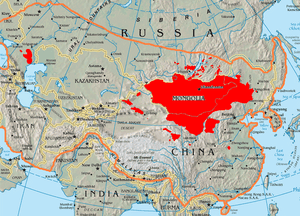
Since 1990, English has become the most popular foreign language. Before, Russian was very important. Many students studied in the Soviet Union. Now, Mongolia's education system focuses more on the West. English is the main foreign language. This is helped by free media and international aid. In the 2014–2015 school year, 59% of students studied English. In 2023, English was declared the "first foreign language." It is taught from the third grade.
The most popular foreign languages in special courses are English, Chinese, Russian, Japanese, and Korean. Korean is popular because many Mongolians work in South Korea.
Religion in Mongolia
| Religion | Population | Share |
|---|---|---|
| Non-religious | 1,338,528 | 40.6% |
| Religious | 1,958,338 | 59.4% |
| Buddhism | 1,704,480 | 51.7% |
| Islam | 105,500 | 3.2% |
| Shamanism | 82,422 | 2.5% |
| Christianity | 42,859 | 1.3% |
| Other religions | 23,078 | 0.7% |
| Total | 3,296,866 | 100.0% |
According to the 2020 National Census, 59.4% of Mongolians aged 15 and older were Buddhists. About 40.6% were non-religious.
Mongolian shamanism has been practiced for a long time in Mongolia. It was common among Central Asian nomads. Over time, it slowly gave way to Tibetan Buddhism. However, shamanism still influences Mongolian religious culture and is practiced today. Kazakhs in western Mongolia and some other Turkic people follow Islam.
For much of the 20th century, the communist government limited religious practices. They targeted the Buddhist Church, which was linked to the old government. In the late 1930s, the government closed almost all of Mongolia's 700 Buddhist monasteries. They also killed at least 30,000 people, including 18,000 lamas (Buddhist teachers). The number of Buddhist monks dropped from 100,000 in 1924 to just 110 in 1990.
When communism fell in 1991, people could practice religion freely again. Tibetan Buddhism became the most popular religion once more. The highest-ranking lama in Mongolia has been vacant since 2012. The search for the next leader is complicated by China's desire to control Tibetan Buddhism.
Other religions also grew after 1990. The number of Christians grew from four in 1989 to about 40,000 by 2008. In May 2013, The Church of Jesus Christ of Latter-day Saints celebrated 20 years in Mongolia. They had 10,900 members and 16 church buildings. There are about 1,000 Catholics in Mongolia. In 2003, a missionary from the Philippines became Mongolia's first Catholic bishop.
Government and Politics
Mongolia is a semi-presidential democratic republic. The people directly elect the President. They also elect members of the national assembly, called the State Great Khural. The president chooses the prime minister. The prime minister then suggests cabinet members. Mongolia's constitution protects many freedoms, including freedom of expression and religion.
Mongolia changed its constitution in 2019. This moved some powers from the president to the prime minister. On May 31, 2023, Mongolia's parliament approved another change. This increased the number of seats from 76 to 126. It also changed the election system to include proportional party voting.
Mongolia has several political parties. The largest are the Mongolian People's Party and the Democratic Party. The organization Freedom House considers Mongolia to be a free country.
The People's Party ruled from 1921 to 1996 (as a one-party system until 1990). They also ruled from 2000 to 2004. From 2004 to 2006, they were part of a coalition government. In June 2020, the MPP won a large victory in the election. They took 62 of the 76 seats. The main opposition, the Democratic Party, won 11 seats.
In January 2021, Prime Minister Ukhnaagiin Khürelsükh resigned after protests. On January 27, 2021, Luvsannamsrai Oyun-Erdene of the MPP became the new prime minister. He is part of a younger generation of leaders who studied abroad.
The President of Mongolia can veto laws made by parliament. They also appoint judges and ambassadors. Parliament can overrule a veto with a two-thirds vote. To be president, a candidate must be a native-born Mongolian. They must be at least 45 years old. They also need to have lived in Mongolia for five years before taking office. The president must stop their party membership.
In June 2021, former Prime Minister Ukhnaa Khurelsukh became the country's sixth democratically elected president. He was the candidate for the ruling Mongolian People's Party (MPP).
Mongolia has a unicameral legislature, the State Great Khural. It has 76 seats and is led by the Speaker of the House. Members are elected every four years by popular vote. The 2023 constitutional change increased the number of seats from 76 to 126.
Foreign Relations
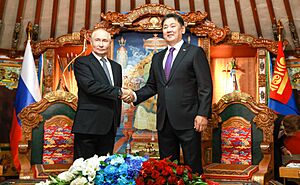
Mongolia's foreign relations mostly focus on its two big neighbors, Russia and China. Mongolia relies on these countries for its economy. China is Mongolia's biggest export partner, taking 78% of its exports. Mongolia gets 36% of its imports from China and 29% from Russia. Mongolia is also working with China and Russia on the Power of Siberia 2 natural gas pipeline.
Mongolia has also started to build good relationships with many other countries. It focuses on encouraging foreign direct investment and trade. Since the early 1990s, Mongolia has followed a 'third-neighbor' foreign policy. This means building stronger ties with countries beyond Russia and China.
Mongolia has been a member of The Forum of Small States (FOSS) since it started in 1992. In 2011, then U.S. Vice President Joe Biden visited Mongolia. He supported Mongolia's third neighbor policy.
Embassies
Mongolia has many diplomatic missions in other countries. It has embassies in these world capitals:
Military of Mongolia
Mongolia supported the 2003 invasion of Iraq. It sent troops to Iraq several times. About 130 troops were also sent to Afghanistan. 200 Mongolian troops are in Sierra Leone. They are there on a UN mission to protect a special court. In July 2009, Mongolia decided to send a battalion to Chad to support MINURCAT.
From 2005 to 2006, about 40 troops were in Kosovo. In 2004, Mongolia became the newest Asian partner of the Organization for Security and Co-operation in Europe (OSCE).
Administrative Divisions
Mongolia is divided into 21 provinces (aimags). These are then divided into 330 districts (sums). Ulaanbaatar is a separate capital city with provincial status. The aimags are:
- Arkhangai
- Bayan-Ölgii
- Bayankhongor
- Bulgan
- Darkhan-Uul
- Dornod
- Dornogovi
- Dundgovi
- Govi-Altai
- Govisümber
- Khentii
- Khovd
- Khövsgöl
- Ömnögovi
- Orkhon
- Övörkhangai
- Selenge
- Sükhbaatar
- Töv
- Uvs
- Zavkhan
Major Cities
Ulaanbaatar (44.2%) Erdenet (3.1%) Darkhan (2.6%) Choibalsan (1.4%) Mörön (1.3%) Nalaikh (1.2%) Ölgii (1.2%) Arvaikheer (1.0%) Bayankhongor (1.0%) Khovd (1.0%) Other (42%)
As of 2020, 47.6% of Mongolians live in Ulaanbaatar. Another 21.4% live in cities like Darkhan and Erdenet. The remaining 31.0% live in rural areas.
|
Largest cities or towns in Mongolia
National Statistics Office of Mongolia, 2020 |
||
|---|---|---|
| Rank | Name | Pop. |
| 1 | Ulaanbaatar | 1,426,645 |
| 2 | Erdenet | 101,421 |
| 3 | Darkhan | 83,213 |
| 4 | Choibalsan | 46,683 |
| 5 | Mörön | 41,586 |
| 6 | Nalaikh* | 38,690 |
| 7 | Ölgii | 38,310 |
| 8 | Arvaikheer | 33,743 |
| 9 | Bayankhongor | 31,948 |
| 10 | Khovd | 31,081 |
*Under Ulaanbaatar administration
Economy of Mongolia
Mongolia's economy has long relied on herding animals and farming. However, developing its large mineral deposits has become a major part of its industry. These minerals include copper, coal, molybdenum, tin, tungsten, and gold. Mining makes up 21.8% of the country's economy. Agriculture makes up 16%. Other important industries are trade, transportation, and real estate. Mongolia also produces one-fifth of the world's raw cashmere.
The World Bank says Mongolia's future looks good because of mining growth. However, challenges like inflation and less demand from China remain. According to the Asian Development Bank, 27.1% of Mongolians lived below the poverty line in 2022. In the same year, the average income per person was about $12,100.
Mongolia's economy grew by 7% in 2023. This was due to record-high coal production, driven by strong demand from China. Inflation dropped to 7% in early 2024. This was because global food and fuel prices were lower. The International Monetary Fund expects mining to keep the economy growing.
In 2011, Citigroup analysts called Mongolia one of the "global growth generating" countries. These are countries expected to grow a lot between 2010 and 2050. The Mongolian Stock Exchange, started in 1991, is one of the world's smallest. As of 2024, it has 180 companies listed.
Mineral Industry
Minerals make up over 80% of Mongolia's exports. This is expected to rise to 95%. Money from mining was 21% of government income in 2010 and 24% in 2018. About 3,000 mining licenses have been given out. Mining is growing as a major industry. Many Chinese, Russian, and Canadian companies are starting mining businesses in Mongolia.
In 2009, the Mongolian government made a deal with Rio Tinto and Ivanhoe Mines. This was to develop the Oyu Tolgoi copper and gold deposit. It was the biggest foreign investment project in Mongolia at the time. The mine now produces a lot of copper and gold. There are plans to increase underground production to 500,000 tons of copper per year. Mongolia's gold production in 2015 was 15 metric tons.
Mongolian lawmakers have also tried to develop the Tavan Tolgoi area. This is the world's largest untouched coal deposit. In September 2022, Mongolia built a 233 km (145 miles) direct rail link to China. This is a big step in Mongolia's plan to become China's main supplier of high-quality coal from the Tavan Tolgoi mine. This mine has over six billion tonnes of coal.
Infrastructure
Communications
Postal services are provided by the state-owned Mongol Post and 54 other licensed companies.
Energy
Mongolia imports 98% of its fuel. It is building its first oil refinery. This will help reduce its reliance on foreign energy.
Transportation
The Trans-Mongolian Railway is the main train link between Mongolia and its neighbors. It connects to the Trans-Siberian Railway in Russia. It runs through Ulaanbaatar and then into China. Another rail link connects the eastern city of Choibalsan to the Trans-Siberian Railway. However, this link is closed to passengers after the Mongolian town of Chuluunkhoroot. Mongolia also has a 233 km (145 miles) cargo rail link. This connects the Tavan Tolgoi coal mine to the Chinese border.
Mongolia has several domestic airports. Some of them also handle international flights. The main international airport is Chinggis Khaan International Airport. It is about 52 km (32 miles) south of Ulaanbaatar. There are direct flights between Mongolia and countries like South Korea, China, Japan, Russia, and Germany. MIAT Mongolian Airlines is Mongolia's national airline. Other airlines like Aero Mongolia and Hunnu Airlines fly domestic and short international routes.
Many roads in Mongolia are gravel or simple tracks. There are paved roads from Ulaanbaatar to the Russian and Chinese borders. There are also paved roads from Ulaanbaatar east and west (the "Millennium Road"). More road construction projects are happening. Mongolia has 4,800 km (2,983 miles) of paved roads. About 1,800 km (1,118 miles) of that was finished in 2013 alone.
Education in Mongolia
During the socialist period, education in Mongolia improved a lot. Before the People's Republic, very few people could read or write. By 1952, almost everyone could read. This was partly thanks to seasonal boarding schools for nomadic children. Funding for these schools was cut in the 1990s, which led to a slight increase in illiteracy.
Primary and secondary education used to last ten years. It was later expanded to eleven years. Since the 2008–2009 school year, new first-graders have been using a 12-year system. The full change to the 12-year system happened in the 2019–2020 school year.
As of 2006, English is taught in all secondary schools in Mongolia. It starts in fourth grade. English has become the main foreign language in Mongolia, especially in Ulaanbaatar. It has replaced Russian.
Mongolian national universities are all connected to the National University of Mongolia and the Mongolian University of Science and Technology. Almost three out of five young Mongolians now go to university. The number of students increased six times between 1993 and 2010.
Culture of Mongolia
The symbol on the left side of the national flag is a Buddhist icon called Soyombo. It represents the sun, moon, stars, and heavens. This comes from traditional Buddhist paintings.
Visual Arts
Before the 20th century, most fine art in Mongolia was for religious purposes. So, Mongolian art was greatly influenced by religious texts. Thangkas were often painted or made with fabric. Bronze sculptures usually showed Buddhist gods. Many great works are linked to the first Jebtsundamba Khutuktu, Zanabazar.
In the late 19th century, painters like "Marzan" Sharav started painting in more realistic styles. Under the Mongolian People's Republic, socialist realism was the main painting style. However, traditional thangka-like paintings about everyday life and national themes were also popular. This style is called "Mongol zurag".
Modern art began to appear after the changes in the late 1980s. Otgonbayar Ershuu is a well-known Mongolian modern artist in the Western world. He was featured in the film "ZURAG."
Architecture
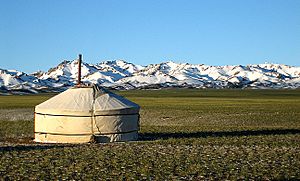
The traditional Mongolian home is called a ger. In the past, it was known by the Russian word yurt. However, the Mongolian term is becoming more common in English. According to Mongolian artist N. Chultem, the ger was the base for traditional Mongolian architecture. In the 16th and 17th centuries, many monasteries were built. Many started as ger-temples. When they needed to be bigger, architects used shapes with 6 and 12 sides. These had pyramid roofs to look like the round ger. Later, temples became square.
Chultem identified three styles in Mongolian architecture: Mongolian, Tibetan, and Chinese. There were also combinations of these. One of the first square temples was Batu-Tsagaan (1654), designed by Zanabazar. The Dashi-Choiling lamasery in Ulaanbaatar is an example of ger-style architecture. The Lavrin temple (18th century) in the Erdene Zuu lamasery was built in the Tibetan style. The Choijing Lamiin Sume lamasery (1904) is an example of Chinese-style architecture. It is now a museum.
Music
Mongolian music is greatly influenced by nature, nomadic life, shamanism, and Tibetan Buddhism. Traditional music uses various instruments. The morin khuur (horsehead fiddle) is famous. Singing styles include the urtyn duu ("long song") and throat-singing (khoomei). The "tsam" dance is performed to ward off evil spirits. It is similar to shamanic practices.
Media
Mongolian press started in 1920. It was closely linked to the Soviet Union and the Mongolian Communist Party. The newspaper Unen ("Truth") was like the Soviet Pravda. Until the 1990s, the government controlled all media. No independent media was allowed. The fall of the Soviet Union greatly affected Mongolia. The country moved to a multi-party democracy. With this, media freedoms became important.
A new law on press freedom was passed on January 1, 1999. This opened the way for media changes. Today, Mongolian media has about 300 print and broadcasting outlets.
Since 2006, the media environment has improved. The government has discussed a new Freedom of Information Act. Media outlets are no longer linked to the government. More people are working in media. More students are studying journalism.
In 2016, Reporters Without Borders ranked Mongolia 60th out of 180 countries for press freedom. A 2014 survey found that 80% of Mongolians get their news from television.
Mongolian Cuisine
Mongolian cuisine mainly includes meat and dairy products. This is because of the nomadic lifestyle. The most common meat is mutton. Other meats like beef, goat, and horse are also eaten. Dairy products include milk, yogurt, and cheese. A popular dish is buuz, which are steamed dumplings filled with meat. Khuushuur are fried meat pastries. Aaruul are dried curds, a common snack. Suutei tsai is a traditional milk tea, often with salt.
Sports and Festivals
The main national festival is Naadam. It has been held for centuries. It takes place over three days in the summer. It features three traditional Mongolian sports: archery, cross-country horse-racing, and wrestling. These are known as the Three Manly Games of Naadam. Today, Naadam is held from July 11 to 13. It celebrates the anniversaries of the National Democratic Revolution and the founding of the Great Mongol State.
Another popular activity is Shagaa. This involves flicking sheep ankle bones at a target. Older Mongolians enjoy this contest at Naadam.
Horse riding is very important to Mongolian culture. The long-distance races at Naadam are one example. Trick riding is also popular. A legend says the hero Damdin Sükhbaatar could pick up coins from the ground while riding a horse at full speed.
Mongolian wrestling is the most popular Mongol sport. It is a highlight of Naadam. Historians believe it started about seven thousand years ago. Hundreds of wrestlers from across the country compete.
Other sports like basketball, weightlifting, and football have also become popular. Many Mongolian table tennis players compete internationally.
Freestyle wrestling has been practiced in Mongolia since 1958. Mongolian freestyle wrestlers have won the most Olympic medals for Mongolia.
Naidangiin Tüvshinbayar won Mongolia's first Olympic gold medal in judo.
Amateur boxing started in Mongolia in 1948. The Mongolian Olympic boxing team was formed in 1960. The government banned boxing from 1964 to 1967 but soon ended the ban. Professional boxing began in the 1990s.
The Mongolia national basketball team has had some success, especially at the East Asian Games.
Football is also played in Mongolia. The Mongolia national football team started playing national games again in the 1990s. However, it has not yet qualified for a major international tournament. The Mongolian Premier League is the top domestic competition.
Several Mongolian women have done well in pistol shooting. Otryadyn Gündegmaa won a silver medal at the 2008 Olympic Games. Munkhbayar Dorjsuren is a double world champion and Olympic bronze medalist.
Mongolian sumo wrestler Dolgorsürengiin Dagvadorj won 25 top division tournaments. This puts him fourth on the all-time list. In January 2015, Mönkhbatyn Davaajargal won his 33rd top division championship. This gave him the most in sumo history.
Bandy is the only sport where Mongolia has finished higher than third place at the Asian Winter Games. This happened in 2011, when the national team won the silver medal. Mongolia won the bronze medal in the B division at the 2017 Bandy World Championship.
Ulaanbaatar holds an annual marathon in June. The race starts at Sukhbataar Square. It is open to residents and runners who come for the event.
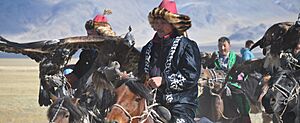
Mongolia has other traditional festivals throughout the year. The Golden Eagle Festival is held annually. About 400 eagle hunters on horseback compete with their birds. The Ice Festival and the Thousand Camel Festival are also popular.
Mongolia in Film
The Eagle Huntress is a 2016 documentary film. It tells the story of Aisholpan Nurgaiv, a 13-year-old Kazakh girl from Mongolia. She tries to become the first female eagle hunter to compete in the eagle festival.
In winter 2023, Australian filmmakers filmed two horse herders, Batbold (18) and Tsagana (22). They herded about 2000 animals across the Tsaikhir Valley. This was a traditional journey to find safer grazing for the horses. This practice is becoming less common due to climate change. Also, young Mongolians are moving to cities for work. The film about this journey is called Iron Winter. It will be shown at the Melbourne International Film Festival in August 2025.
See also
 In Spanish: Mongolia para niños
In Spanish: Mongolia para niños
- Index of Mongolia-related articles
- Outline of Mongolia





